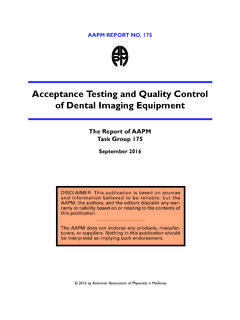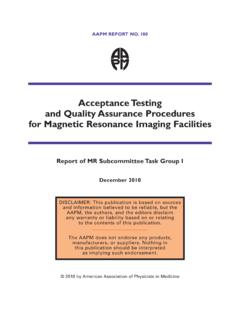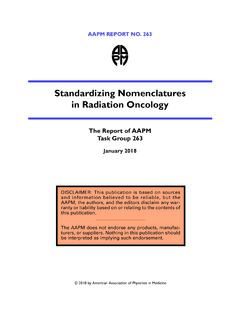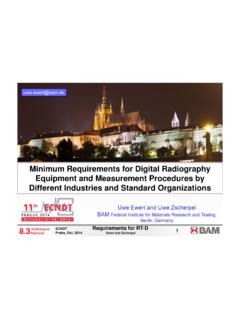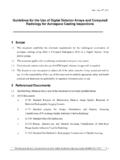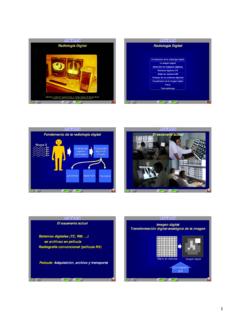Transcription of Acceptance Testing and Quality Control of …
1 AAPM REPORT NO. 93 Acceptance Testing and Quality Controlof photostimulable storage phosphor imaging SystemsReport of AAPM Task Group 10 October 2006 2006 by American Association of Physicists in MedicineDISCLAIMER: This publication is based on sources and information believed to be reliable, but the AAPM and the editors disclaim any warranty or liability based on or relating to the contentsof this AAPM does not endorse any products, manufacturers, or suppliers. Nothing in this publication should be interpreted as implying such : This publication is based on sources and information believed to be reliable, but the AAPM, the editors, and the publisher disclaim any warranty or liability based on or relating to the contents of this AAPM does not endorse any products, manufacturers, or suppliers. Nothing in this publication should be interpreted as implying such : 978-1-888340-64-8 ISBN-10: 978-1-888340-64-9 ISSN: 0271-7344 2006 by American Association of Physicists in MedicineAll rights reserved.
2 No part of this publication may be reproduced, stored in a retrieval system , or transmitted in any form or by any means (electronic, mechanical, photocopying, recording, or otherwise) without the prior written permission of the byAmerican Association of Physicists in MedicineOne Physics EllipseCollege Park, MD 20740-3846 AAPM REPORT NO. 93 Acceptance Testing and Quality Controlof photostimulable storage phosphor imaging SystemsReport of AAPM Task Group 10 Task Group Members:J. Anthony Seibert (Chair) Terese M. BoguckiTed CionaWalter Huda Andrew KarellasJohn R. MercierEhsan Samei S. Jeff ShepardBrent K. StewartKeith J. StraussOrhan H. Suleiman Doug TuckerRobert A. UzenoffJohn Conrad Weiser Charles E. WillisThis page intentionally left Image Acquisition .. Detector and Absorption Process .. and Readout Process .. Laser Laser Laser Readout.
3 Signal Erasure .. and Conversion of the PSL Signal .. Characteristic the Raw PSP vs. Unwanted Image Signals .. Pattern and Exposure Field Grayscale Adjustments .. Image Processing .. Demographics and Exposure and Processing Systems .. Systems .. Systems .. Concerns When Using PSP Systems .. system Image Resolution .. Quantum Efficiency (DQE) .. Display .. Functional Specifications of PSP Detectors and Cassettes .. Detector Resolution .. Range .. Specifications and Plates, Cassettes, Grids, Identification Hard-Copy Image Exposure Examination; Other Data Processing Demographics and Film Marker Positioning .. system Interfaces to RIS, HIS, and PACS.
4 Control Phantom; QC Workstation and Software .. Contracts, Preventive Maintenance, Warranty, and Siting Requirements .. Training for Technologists, Radiologists, Physicists, Clinical Engineers .. Implementation and Realities .. Concerns .. Scatter and Grid Selection .. Exposure .. system Interfaces to PACS .. Training .. Acceptance .. Communication with Vendor Engineer/Specialist .. and Initial Adjustments for Acceptance Test Measurements .. of Alphanumeric Data Recording .. of the Hard-Copy Recording Device .. Processor and Laser Printer Tests .. Printer Calibration and LUT Workstation Display Monitor Calibration/Resolution Tests .. of PSP system Interfaces: RIS and PACS .. of the X-ray and Equipment Required for Acceptance Testing Procedures.
5 Plate Dark Noise and Uniformity .. Indicator Calibration Linearity and Autoranging Beam Resolution and Resolution and Low-Contrast Resolution .. Distance Accuracy .. Aliasing/Grid Response .. IP Throughput .. Acceptance Criteria and Quantitative Relationships .. Image Processing: LUT Transforms and Frequency Artifacts .. Artifacts .. Artifacts .. 6010. Quality Control and Periodic Daily Tests (Technologist) .. Monthly Tests (Technologist).. Quarterly Tests (Technologist) .. Annually and After Major Repair/Calibration (Physicist) .. 6211. 62 Appendix A. Manufacturer Contact 63 Appendix B. Sample Acceptance Testing and Quality Control 64 CONTENTSThis page intentionally left phosphor (PSP) imaging , also commonly known as computed radiography(CR), employs reusable imaging plates and associated hardware and software to acquire and todisplay digital projection radiographs.
6 Procedures to guide the diagnostic radiological physicistin the evaluation and continuous Quality improvement of PSP imaging practice are the specificgoal of this task group report. This document includes an overview of a typical PSP imaging sys-tem, functional specifications, Testing methodology, and a bibliography. The main body of thereport includes a description of generic, non-invasive tests that are applicable to a variety of PSPunits. Since the inception of the task group, technological advances have changed the scope ofits original goals. In particular, when the task group was initially formed, film was the chief dis-play medium, and video display monitors and associated analysis software were not widelyavailable. Also noted are the significant advances of direct radiography, which includes thedirect acquisition and readout of projection radiographs without physical handling of a PSPimaging plate.
7 The user of this information should realize that technological change is constant,and many of the tests described in this document might not be applicable with the current stateof the art. In these situations, the user is encouraged to consult the manufacturer, the AmericanAssociation of Physicists in Medicine (AAPM), or other pertinent contemporary sources foradditional page intentionally left INTRODUCTIONThe primary purpose of this document is to guide the clinical medical physicist in the accept-ance Testing of photostimulable phosphor (PSP) imaging systems. PSP imaging devices (modali-ties) are known by a number of names including (most commonly) computed radiography (CR), storage phosphor imaging , photostimulable storage phosphor imaging , digital storage phos-phor imaging , anddigital luminescence radiography. PSP images are readily integrated into apicture archiving and communication system (PACS) via widely implemented communicationsstandards including Digital imaging and Communications in Medicine (DICOM)1and HealthLevel 7 (HL7).
8 2 The tests described herein are appropriate for PSP systems in either integratedor stand-alone applications. Digital imaging technology is rapidly evolving, and this effort rep-resents the state of technology as of its writing. Proper application of this guide involves supple-menting it with current literature and specific manufacturer s technical secondary purpose is to provide a consolidated source of information regarding devicefunctionality, Testing , and clinical practice of PSP imaging . This document provides the physicistwith a means to conduct initial Acceptance Testing , to interpret results, and to establish baselineperformance. A subset of these tests can be extended to routine Quality Control (QC). 2. system OVERVIEWThe basic principles and operating characteristics of PSP systems are covered in this section,including acquisition methods, PSP detector characteristics, the readout process, and the detec-tor characteristic response.
9 Detailed information on the physics of computed radiography isavailable from the review article by PSP Image AcquisitionThe photostimulable phosphor (PSP) stores absorbed x-ray energy in crystal structure traps, and is sometimes referred to as a storage phosphor . This trapped energy can be released ifstimulated by additional light energy of the proper wavelength by the process of photostimulatedluminescence (PSL). Acquisition and display of the PSP image can be considered in five gener-alized steps, illustrated in Figure unexposed PSP detector, commonly known as an imaging plate (IP), is placed in acassette with a similar form factor and appearance of a screen-film cassette. X-ray geometry andimaging techniques are also similar to screen-film acquisition. During the exposure, x-rays aretransmitted through the patient and are absorbed by the IP.
10 Energy deposited in the PSP materialcauses local electrons to be elevated from an equilibrium (ground state) energy level to a stable trap known as an F-center. This is the unobservable electronic latent image, whereby thenumber of electrons trapped is proportional to the number of x-ray photons incident on the exposed IP in step 1 of Figure 1 must be read out to produce the x-ray image. In step 2, thecassette is placed in the reader where the IP is extracted and raster-scanned with a highly focusedand intense laser light of low energy (~2 eV). Trapped electrons in the PSP matrix are stimulatedby the laser energy, and a significant fraction return to the lowest energy level within the phosphor ,with a simultaneous release of PSL of higher energy (~3 eV). The intensity of PSL, proportionalto the number of released electrons, is optically filtered from the laser light and captured by alight guide assembly in close proximity to the IP.



